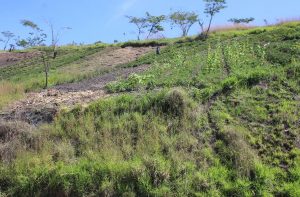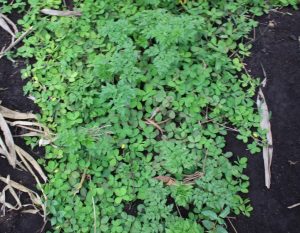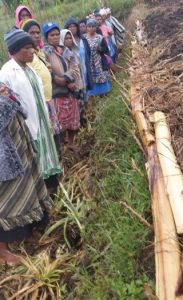CDWAI story begins with people and their gardens. We believe God created a beautiful world and a core element of our work is to care for the people and the natural world. Sadly, our first image on this page speaks to massive degradation. Loss of soil, rampant fire and dwindling forest resources are all challenges that are best met by local people caring for their local areas. There is a lot of work to do.

Creating barriers in gardens is one way to make a difference.

 Community Development Workers Association Inc. (CDWAI) is a formally registered NGO. We are small and involved in the hard places – remote, challenging and folk really appreciate our team’s input. We’ve grown from a team based out of UniTech and Mission partnership in the 1990’s, working in sustainable agriculture, rabbit farming and concern for a long term approach to gardens and livelihoods. During the 1997 El Nino drought and again during the drought of 2015/16 teams from CDWAI partnered with NZ Government to provide training and water technology especially in Enga, Simbu and Telefomin district.
Community Development Workers Association Inc. (CDWAI) is a formally registered NGO. We are small and involved in the hard places – remote, challenging and folk really appreciate our team’s input. We’ve grown from a team based out of UniTech and Mission partnership in the 1990’s, working in sustainable agriculture, rabbit farming and concern for a long term approach to gardens and livelihoods. During the 1997 El Nino drought and again during the drought of 2015/16 teams from CDWAI partnered with NZ Government to provide training and water technology especially in Enga, Simbu and Telefomin district.

Our teams have trained and continue to train in remote places – ecology, leadership, conflict resolution, garden and soil management. We honour God’s plan for creation – seeking to care for a beautiful planet and folk whose livelihoods come direct from the land and gardens.
Over 2017 and 2018 CDWAI is partnering with the Tsak Rural Women’s Empowerment Foundation in Wapenamanda District, Enga Province in the PNG Highlands. Some reports will find their way into the library. You can download whole documents.
More recently the focus is on working with women in their gardens… encouraging more sustainable practices. Historically around Goroka, pineapples are a cash crop and soil loss is massive, given how much soil is bare especially while pineapples are establishing. We encourage the use of mulch, green manures, alleys/contour barriers and drainage ditch barriers to slow water down, dramatically reducing erosion.

Demonstration of erosion – the mound on the left was covered with leaves and twigs, the mound on right was open to the sun and ‘rain’ from our watering can. The mound on left lost almost no soil during our heavy ‘rain’ from watering can. The mound on right lost a lot of soil. These are simple demonstrations to help people realise their soil loss challenges – then we move to what they can do, without needing cash for special, external technologies.
In ditches forage peanut and the commonly used vegetable – smel kumu help slow topsoil loss and provide food for livestock and people – in the ditch!

